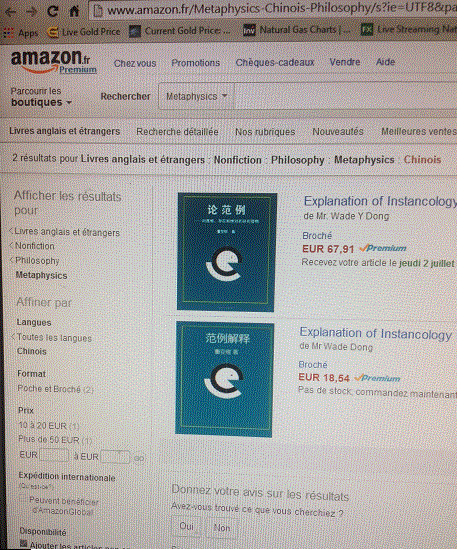Why Instancology Is Not Just Another philosophy
Beyond the Macro: Why Instancology Is Not Just Another Philosophy
Introduction
Philosophy has long claimed to seek the truth of Being, reality, or the Absolute. But throughout history—from Plato and Aristotle to Kant, Hegel, and Heidegger—this search has been conducted within a specific ontological framework: the Macro-World.
What distinguishes Instancology, a new system developed by Dong Yawei, is not simply that it presents a new theory of metaphysics. It is that it leaves the Macro-World entirely, and in doing so, it breaks from the entire lineage of symbolic and representational thought. This is not a modification of philosophy. It is a structural departure. And that is why it cannot be reduced to a mere inversion (top-down vs. bottom-up), nor to a repackaging of deduction and induction.
I. Defining the Layers of Reality in Instancology
Instancology proposes that all things occur in one of four ontological layers, each with distinct characteristics:
Layer Name Description
RR Relative Relative Human-made constructs: language, logic systems, values, culture—everything symbolic and contingent
AR Absolute Relative Nature and natural phenomena—matter, energy, time, space. Natural but still contingent (accidental)
RA Relatively Absolute The realm of necessity—law, logic, structure—not in symbol but as pure being. This is the Micro-World
AA Absolutely Absolute The unspeakable Whole—the ultimate, unrepeatable background of all being. Beyond thought and language
In this structure:
Macro-World = RR + AR
→ Everything here is accidental, subject to change, emergence, contingency, and interpretation.
Micro-World = RA
→ Everything here is necessary, not symbolized, not accidental, and not emergent. It must be, as it is.
The AA is beyond both worlds. It is not a domain, but the non-domain that allows all domains.
II. The Hidden Limitation of All Past Philosophy: Trapped in the Macro
The greatest thinkers in history—Plato, Descartes, Kant, Hegel, Wittgenstein, Heidegger—each made powerful contributions. Yet they all worked within the bounds of the Macro-World:
RR: Through language, concepts, logic, ethics, epistemology, and symbolic systems
AR: Through reference to nature, mind-body dualism, experience, or physicality
Even metaphysics, which aims at the Absolute, has remained representation-bound. The best it has done is gesture toward transcendence (Kant’s noumenon, Hegel’s Spirit, Heidegger’s Sein)—but always within the interpretive frame of RR or the observable frame of AR.
What philosophers called “truth” was accidental truth—relative to conditions, contexts, frameworks, or perspectives.
III. Instancology’s First Break: From Macro-World to Micro-World
The first major rupture in Instancology is the move from accidentality to necessity. That is: from the Macro-World (RR + AR) to the Micro-World (RA).
Here, a fundamental change occurs:
Macro-World: The world of becoming, emergence, contingency
Micro-World: The world of structure, necessity, pure law, not as a concept but as reality without symbol
This is not simply a return to rationalism or an abstraction of laws. The Micro-World is not an idea. It is a layer of being where reality is unfolded through necessity, not described through symbol. It cannot be seen, represented, or hypothesized. It can only be recognized—through what Instancology calls 悟性 (WuXing), a type of intuitive insight that transcends both deduction and induction.
IV. Instancology’s Second Break: From Necessity to the Unspeakable
Instancology does not stop at necessity. It moves further—into the Absolutely Absolute (AA), the ultimate Whole.
Where RA is structural necessity, AA is ontological silence—a non-representable, non-logical, unrepeatable Whole that underlies even the necessary. It is not the sum of truths. It is the condition for any truth or being to exist.
This second break is what makes Instancology categorically different from even the boldest metaphysical systems of the past. While others approached the Absolute through dialectics, negation, or mystical surrender, Instancology constructs a ladder:
RR → AR → RA → AA
And it does so with clear epistemological and ontological distinctions at each level.
V. Addressing Common Misunderstandings
Some critics claim Instancology is just another top-down philosophy. But this misunderstands what is being “topped” or “bottomed.” The issue is not direction, but ontology: Instancology does not reverse past systems. It leaves them.
Others argue it reuses deduction or induction. But WuXing is neither:
Deduction requires formal systems (RR)
Induction requires data and pattern (AR)
WuXing is alignment with necessity (RA), and ultimately, silent recognition of the Whole (AA)
This is not a new method. It is a new mode of being in truth.
Conclusion: Why This Is a Break, Not a Bridge
Instancology does not reinterpret past philosophy. It finishes it. It recognizes that philosophy has exhausted its possibilities within the Macro-World. What remains is to step beyond it—into the necessary structure (RA), and ultimately, the Whole (AA).
This is not a matter of theory, but of ontological reorientation.
From chasing accidental truths to standing in necessity.
From modeling the world to being in the Whole.
That is why Instancology is not merely “another philosophy.”
It is the closure of philosophy and the opening of truth.
